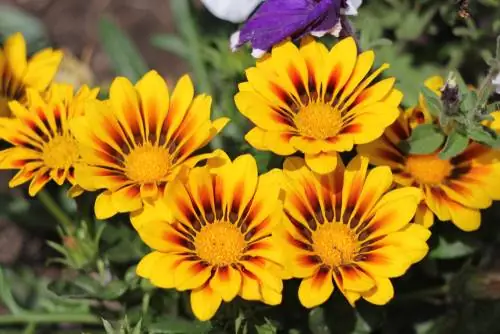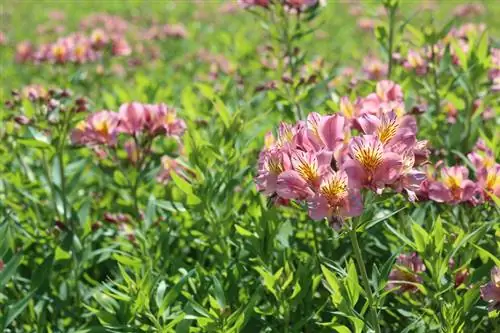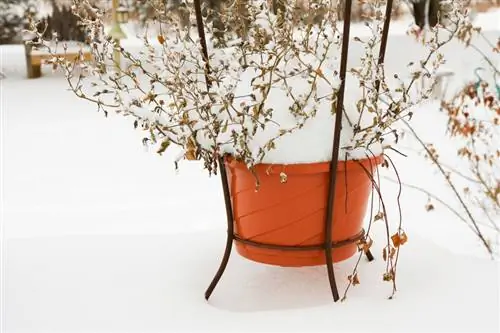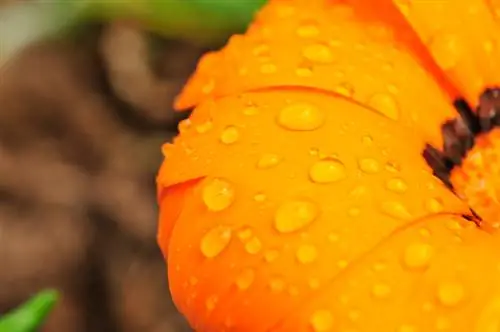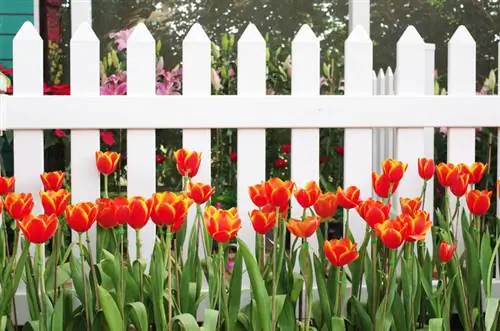- Author admin [email protected].
- Public 2023-12-25 17:45.
- Last modified 2025-01-23 11:21.
Gazania, also known as midday gold or midday gold flower, only opens its colorful flowers on sunny days - hence its German name. The pretty bed and balcony flowers are not hardy here, but can be cultivated per year. This requires careful care and frost-free wintering. Gazanias should not be confused with the botanically related ice plants (bot. Dorotheanthus).
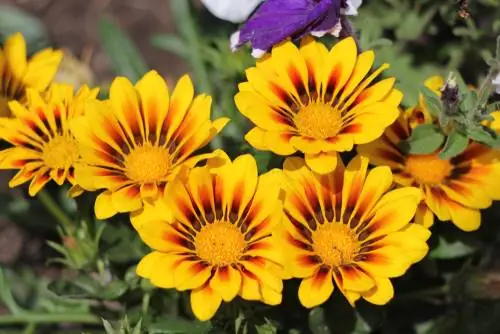
What are gazanias and how to care for them?
Gazanias, also known as midday gold, are colorful, bushy summer flowers that only open their flowers on sunny days. They are not hardy, but can be cultivated perennial if they are overwintered frost-free and cared for carefully. Gazanias are suitable for beds and balconies as well as ornamental plants in gardens and parks.
Origin and distribution
The Gazanias (bot. Gazania) are a genus comprising around 19 different species within the Asteraceae family. Because of their ability to only open the colorful flowers on sunny days from mid-morning to early afternoon, they are sometimes mistakenly classified as ice plants. The bushy-growing summer flowers are native to South Africa, where they occur primarily at low altitudes and in sandy locations. The specimens available from us under the name “Mittagsgold” are mostly hybrid breeds from the species Gazania rigens, Gazania nivea and Gazania krebsiana.
Usage
Because of their lack of winter hardiness, gazanias are primarily sold as annual summer flowers for pot and balcony planting. But they also look good in colorful summer flower beds in the garden, especially when they are planted in groups of matching colors. The South African beauties harmonize particularly well with flowers and perennials that bloom in equally bright colors, such as marigolds (marigolds), rudbeckias, lobelias, zinnias or marigolds. The numerous varieties - which are often hybrids - are used worldwide as ornamental plants in gardens and parks.
Appearance and growth
Most Gazania species are perennial, herbaceous plants. They remain quite low in height and, depending on the species and variety, are only between 15 and 30 centimeters high and just as wide. However, the small bushes spread very quickly and form real cushions whose shoots overhang slightly. The narrow, lanceolate leaves sit on the woody shoot axes, which in turn often form a rosette. The foliage is fresh green on the upper side and slightly silvery on the underside. Since midday gold is not hardy, but can be easily propagated from seeds, the plants are usually only cultivated as annuals in this country.
Flowers and flowering time
The daisy-like flower heads, up to ten centimeters in diameter, are numerous on the 15 to 30 centimeter high flower stalks. There are many varieties in different colors from white to pink to red and darker reddish-brown tones. Hybrid varieties with striped petals are particularly attractive. The black spots on the tubular flowers are also characteristic of many species and varieties. Provided they are in a suitable location, Gazanias are tireless, continuous bloomers and show their splendor throughout the summer from June until well into September.
Toxicity
The magnificently blooming gazanias are not poisonous.
Which location is suitable?
Since gazanias only open their magnificent flowers on sunny days, they need a full sun and warm location. If the selected location is too shady or the summer is cloudy and rainy, the flowers will be sparse. Always combine the midday gold with other summer flowers that bloom happily - otherwise, with a bit of bad luck, the flower bed could remain bare. However, when the sun is kind and shines from the sky, gazanias are easy-to-care for long-term bloomers. The plants are ideal not only for planting flower borders and balcony boxes, but also feel very comfortable in the rock garden.read more
Soil / Substrate
Since gazanias grow on rather barren, sandy substrates in their natural habitat, you should also get lean and well-drained soil in the garden. A loose, loamy-sandy garden soil with high water permeability is particularly suitable - the flowers tolerate drought very well, but not moisture. If, on the other hand, the location is too nutrient-rich (which is the case with humus-rich soils), more foliage will form. However, only a few flowers can be seen.
If the midday gold is in the bucket, mix about half of a good standard humus-based soil with coarse sand. Pot drainage is also important so that waterlogging does not occur in the first place. Clay planters not only look attractive, but their breathable material prevents the roots from overheating.
Planting Gazania correctly
You can plant midday gold straight away in locations with sandy, poor soil: rock or prairie gardens as well as dry beds are ideal for the beauties. If, on the other hand, you want the flowers in borders with dark, humus-rich soil, you should dig it up thoroughly to ensure he althy growth, loosen it up and mix in a high proportion of gravel or sand. Soils with high water storage capacity also require a five to ten centimeter thick drainage layer for the planting to be successful. From the end of May onwards - there should be no late frost - plant the gazanias in groups of four to five plants in the bed. Maintain a planting distance of around 15 to 20 centimeters.
pot planting
On a sunny balcony or terrace, the Mittagsgold also feels at home in balcony boxes, bowls or other suitable planters. Place a drainage layer of gravel or expanded clay and ensure that excess water can drain out of a drainage hole at the bottom of the container. Place the plants in potting soil rich in sand (alternatively, you can also use cactus soil) and associate them with flowers that have similar needs in terms of location, substrate and care. For example, lantana, magic bells or hussar buttons are suitable.
Watering and fertilizing
When it comes to care, gazanias don't require much effort: Fertilization should also be avoided in potted specimens, as too many nutrients only stimulate the growth of the leaves - but undermine the ability to flower. Basically, the rule applies: the barer the ground, the more lush the flowers. Watering is only necessary if the soil/substrate is in danger of drying out. Even on hot days, water sparingly - but perhaps more often. A small amount of water administered in the morning and evening is easier for the plant used to dry locations to cope with than a larger amount of water at once.
Cut gazania correctly
Cutting measures are not necessary. You should only clean out the dead flowers regularly so that the plant continues to form new buds and bloom for longer. If the weather is right and there is plenty of sunshine, you can enjoy the pretty flowers until the first frost.
Propagate Gazania
From January to the beginning of April you can choose midday gold from seeds you have collected yourself or bought from specialist retailers. But be careful: Since the species cultivated in this country are often hybrid - i.e. they are crosses - their seeds are often not capable of germinating. Furthermore, the beautiful flower color is no longer visible in flowers propagated from seeds. For these reasons, you should give preference to high-quality seed mixtures (€11.00 on Amazon) from specialist retailers or grow vegetative offspring from cuttings.
This is how you can propagate from seeds:
- Use growing soil with a high sand content
- Do not cover seeds with soil as they germinate in the light
- just press a little and moisten slightly with water from a spray bottle
- warm and bright location
- optimal germination temperature: between 18 and 22 °C
- no direct sun, still plenty of light
- Bright east window is optimal
- Germination time: approx. 15 days
- Prick out as soon as young plants have four to six leaves
- From May onwards, put it outside in the pot during the day and get used to the light
- plant outdoors from the end of May
You take cuttings either from young shoots in early summer (which you then have to overwinter as these plants only bloom the following year) or in early autumn. The cuttings are easier to overwinter than adult plants.read more
Wintering
In their homeland, perennial gazanias often develop into small bushes that become slightly woody at their base. They have a life expectancy of a few years. Here, the pretty flowers are not hardy and difficult to overwinter. The sun-hungry plants suffer from the lack of light in the Central European winter and therefore often develop significantly fewer flowers the following year. If you still want to try it, you should definitely dig up planted gazanias, pot them up and overwinter them as follows:
- Bright, but not directly sunny location (east window or similar)
- Temperature between five and ten degrees Celsius
- water little, do not fertilize
- harden off gradually from April and put outside during the day
- bring it into the house when it's frosty and overnight
- planting from the end of May
By the way, cuttings cut in autumn are easier to overwinter than adult plants.
Diseases and pests
The easy-care Gazania is rather insensitive to diseases and pest infestations. A damp location or too generous watering behavior is particularly problematic: if it is too wet, gray mold or even root rot will develop very quickly. In this case, the affected plant can often no longer be saved and must be disposed of. When planted out, a snail guard is essential in or around the bed, as the hungry reptiles also like to eat the delicate flowers. In unfavorable locations, weakened plants are often attacked by aphids or spider mites.
Tip
If you can have a bare dry stone wall in your garden, you can also plant it with gazanias and create colorful accents.
Species and varieties
We do not offer the botanically pure species of Gazania as garden or pot plants. Instead, a wide selection of different hybrid varieties are available in a wide variety of colors, ranging from monochromatic to multi-colored flowers. In the 'Daybreak' series, for example, you can purchase white, pink, golden yellow and orange flowering varieties with sprawling growth. If, on the other hand, you attach great importance to particularly large flowers, the various varieties from the 'Big Kiss' series with their flower heads, which are up to twelve centimeters in size on average, are just right for you. The variety 'Talent' probably has the longest flowering time and duration of all varieties, whose flowers can appear in white, yellow, orange, pink or brown. The 'Mini Star' variety, on the other hand, appears more compact.
- Yellow flowers: 'Chansonette Yellow', 'Daybreak Orange Cream', 'Kiss Yellow Flame'
- Orange flowers: 'Mini Star Tangerine', 'Daybreak Bright Orange', 'Kontiki Orange'
- Pink flowers: 'Chansonette Plus Pink', 'Daybreak Pink'
- White flowers: 'Mini Star White', 'Kiss Frosty White'

